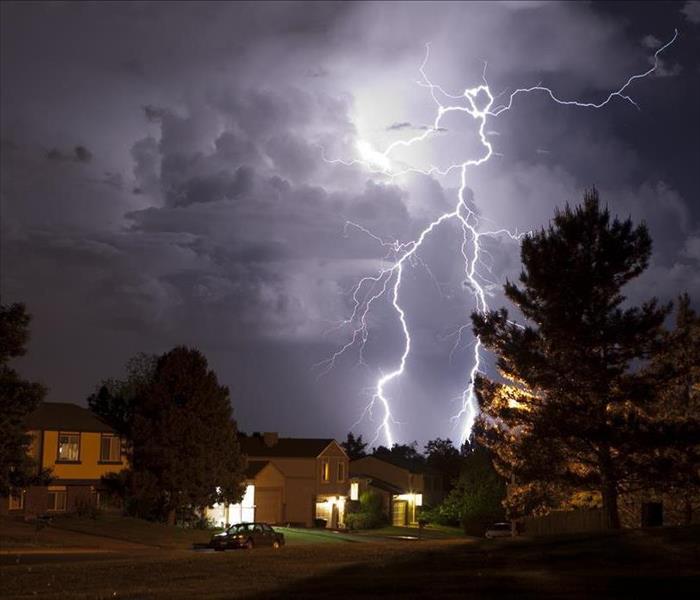What Safety Issues Do Flood Emergencies Cause and How Do Professionals Control Them?
8/19/2020 (Permalink)
 Storms can bring floodwater and storm damage. The professionals at SERVPRO are always on call to handle your water damage restoration needs.
Storms can bring floodwater and storm damage. The professionals at SERVPRO are always on call to handle your water damage restoration needs.
Trust the SERVPRO Management and Crews to Evaluate Carefully for Safety Concerns and Put Proper Controls in Place During Flood Damage Cleanup In North Kingstown.
When hurricanes start off the coast of Africa in the Atlantic, it is hard to imagine that a storm with origins thousands of miles away can severely damage your North Kingstown home days or weeks later. Our location adjacent to Narragansett Bay off the Atlantic puts us squarely in the pathway of severe storms moving up the Eastern Seaboard during the hurricane and tropical storm season. Torrential rains, fierce winds, and storm surge all threaten residences with flood damage every year.
What Kinds of Safety Issues Can Summer and Fall Seasonal Storms Create?
The storms contributing to the flood damage North Kingston homes experience create a long list of significant safety issues that must be discovered, documented, and controlled during the overall restoration project. Here is a non-exhaustive list of the safety concerns we anticipate could be present in your home post-flood damage:
- Water on Surfaces Issues
Slip, trip, and fall
Electric shock or electrocution risks
- Structural Wind and Water Issues
Damage to roofs, windows, siding, and more
Migration from exterior damage, causing caches of water to collect in building cavities, threatening the collapse of structures and injury to occupants and workers
- Overland Flooding and Seepage Issues
Water contaminated with a broad range of dirt, chemicals, and infectious agents, creating a risk of illness or worse to occupants and workers. Contaminants can include:
Industrial yard, roadway, and landscaping chemicals, including pesticides
Dirt, oils, gravel, mud, muck, and organic materials, including dead animals and insects
Sewage from overwhelmed curbside drainage systems or a backup of your own waste line
- Biohazard Exposure
Previously contained materials such as asbestos and lead and newly discovered mold damage all have significant health hazards attached if the substances are breathed in, absorbed through skin contact, or ingested.
- Salt Water Surge
Water containing high levels of salts and other minerals creates short and long term risks for wood, metals, and concrete used as building materials, weakening them substantially and interfering with their load-bearing abilities.
Saltwater also exacerbates the risk of immediate and longer-term electrical shock risks because of heightened conductivity.
- Why Put Such a Focus on Safety? Why Not Just “Dig In” and Get Rid of the Sludge and Water?
SERVPRO knows that dealing with the safety concerns must be “job one” because the injuries and health effects of uncontrolled hazards can be deadly or quality of life-altering. The structural concerns emphasize that the risk assessment must be complete and the interventions planned carefully for human health and structural integrity. It is impossible to dig out the muck and extract water if the surfaces buckle with the weight of equipment and operators become injured or ill on the job.
How Do Professionals Control Safety Risks?
- Simple Water-Related Safety
Setting aside contaminants, we manage the slip, trip, and fall issues with barriers, signage, and fast extraction. Electrical concerns fade when the power temporarily goes off the grid, utilizing our onboard generators or gas for fuel.
- Exterior Damage Issues
Our crew can board up, tarp, and barricade dangers due to storm damage. Keeping additional rainwater out is a key mitigation strategy.
- Contamination and Biohazards
We control the environment within which these dangerous substances exist with many exclusion and containment strategies.
- Until the contaminants are eradicated, we recommended you and your family evacuate from affected areas.
- Our trained and certified technicians wear appropriate personal protective equipment (PPE) while managing the dangerous substances.
- Restoration industry best practices and state, local, and federal laws and regulations mandate and guide how our technicians contain work areas, often with heavy-duty plastic-wrapped partitions and air scrubbing equipment.
- The contaminants -- whether solid debris or fluids -- are contained according to applicable rules and disposed of as hazardous waste
- The Special Safety Constraints of Salt Water
Salt water in a structure poses risks two ways -- first, electrical shock and increased fire possibility, as the salt increases the conductivity of electric currents. This increased conductivity can continue even after the materials dry out as the salt residues remain on wires and connections. Second, the salt load causes wood cells to break down, metal to corrode, and concrete to disintegrate, albeit over a long term. We flush the salt from the structural materials with fresh water to halt the accelerated damage, extracting more water during mitigation, but ensuring the stability of the structure.
Every step SERVPRO of Washington County takes to investigate and evaluate the particular circumstances of flood damage in your home is aimed at making it “Like it never even happened.” Call us round the clock at (401) 315-2337 for an in-depth evaluation of your needs and our ability to meet them.






 24/7 Emergency Service
24/7 Emergency Service